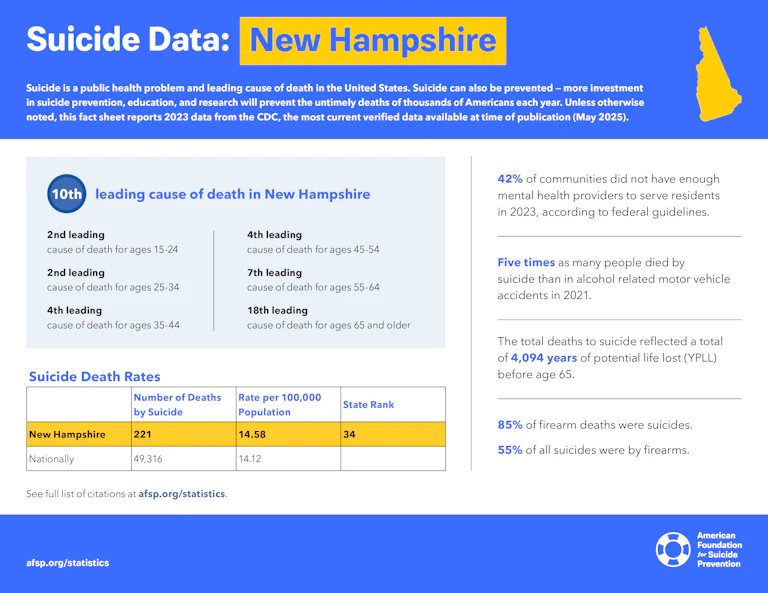New Hampshire

New Hampshire suicide prevention plans and initiatives
In 2008 New Hampshire law established the State Suicide Prevention Council (SPC), now housed within the state’s Department of Health and Human Services, Division of Community Based Care Services, Bureau of Behavioral Health (DHHS/DCBCS/BBH) and tasked the Council with overseeing implementation of the state suicide prevention plan, evaluating its progress, and recommending program changes, funding opportunities, and updated plan priorities (RSA §§ 126-R:1 through R:3 and S.B. 85). The SPC is also charged with promoting policy change on suicide prevention-related matters. In 2021, the SPC revised the state plan and released the New Hampshire Suicide Prevention Plan 2021-2024, along with the plan’s Addendum.
Released each fall, New Hampshire Suicide Prevention Annual Reports are produced by NAMI New Hampshire (National Alliance on Mental Illness) Connect Program, the SPC, and the Youth Suicide Prevention Assembly, an ad hoc committee of individuals and organizations that meets monthly to study suicide prevention and postvention across the lifespan. The reports, which provide a summary of accomplishments and data from the previous year, can all be found on the Connect Program website, including the most recent 2021 Report.
New Hampshire laws
Key:
- Required by law
- Encouraged by law
- No law in place
Crisis lines and 988 implementation
- Addresses 988 infrastructure and provides for telecom user fee
- Addresses 988 infrastructure but does not include telecom user fee
- 988 law limited to creating an exploratory commission, advisory committee, or task force
Mental health parity
- Public health plans (e.g., Medicaid) regularly submit parity compliance analyses to state regulators
- Private health plans (individual and group) regularly submit parity compliance analyses to state regulators
K – 12 school suicide prevention
- Inclusion of the 988 Suicide & Crisis Lifeline and/or other crisis line(s) on student ID cards
- Student allowances for excused mental health absences
- School personnel must report student suicide risk to a parent and/or guardian
- Suicide prevention and/or mental health training for certain school personnel, annual
- Suicide prevention and/or mental health training for certain school personnel, not annual
- Suicide prevention, intervention, and postvention policies/programming
- Student education on suicide prevention
- Student education on mental health
Health professional training in suicide assessment, treatment and management
- Mental health professionals receive regular training
- Mental health professionals receive one time training
- Medical/surgical professionals receive regular training
- Medical/surgical professionals receive one time training
Conversion therapy bans
- Prohibits licensed/board certified mental health providers from engaging in conversion therapy with minors under 18 years of age
- Prohibits licensed/board certified mental health providers from engaging in conversion therapy with vulnerable adults
- Prohibits use of state funds for any purpose related to conversion therapy (e.g., conducting, making a referral for, or extending health benefits coverage for)
University and college campus suicide prevention
- Inclusion of the 988 Suicide & Crisis Lifeline and/or other crisis line(s) on student ID cards
- Students receive information on available mental health and/or suicide prevention services and/or resources
- Adoption of suicide prevention/awareness policy or program
Firearms
- Process for extreme risk protection orders (ERPOs)
- State voluntary do not sell list